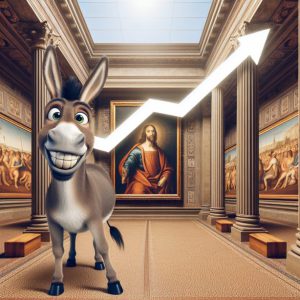
What Development In The Late 1890s May Well Have Prevented Another Financial Disaster?
May 11, 2024
The Unwise and the Unfortunate: A Tale of Late 1890s Folly
In the late 1890s, a series of events unfolded that, if not for the intervention of wise decision-making, could have resulted in another financial disaster. This tale is a stark reminder of the power of human stupidity and the importance of learning from history to avoid repeating its mistakes. The main characters in this narrative are the gold standard, a group of bumbling bankers, and a herd of mentally unstable investors, all of whom played their part in this economic drama.
The Golden Folly
The late 1890s witnessed a peculiar obsession with gold among the decision-makers of the time. Like moths drawn to a fiery flame, these individuals fixated on the shiny metal, believing it to be the ultimate solution to all economic woes. In their infinite wisdom, they decided that tying the value of a nation’s currency to a finite resource buried in the earth was a brilliant idea. Thus, the gold standard, a monetary system that fixed the value of a unit of currency to a specific amount of gold, was embraced like a long-lost treasure.
The gold standard, in theory, promised stability and confidence in a nation’s currency. However, executing this idea was as foolish as a donkey chasing a carrot on a stick. By limiting the supply of money to the amount of gold available, these economic “geniuses” effectively restricted a nation’s ability to respond to financial shocks and fluctuations in demand. It was as if they had collectively decided to shoot themselves in the foot and then proudly proclaimed it as a wise strategy for avoiding blisters.
With its rigid rules and inflexibility, the gold standard became a straitjacket for economies, hindering their ability to adapt and grow. Like a wild beast, it roamed the financial landscape, devouring any hopes of economic progress and stability. Yet, the morons in charge remained steadfast in their belief, blind to the impending disaster that their stubbornness was about to unleash.
Banking Buffoons and Their Shenanigans
Enter the bankers, who fancied themselves as financial sorcerers but behaved more like court jesters. These buffoons, with their fancy suits and even fancier moustaches, thought they could manipulate the system for their gain. Like a pack of wolves, they colluded, conspired, and concocted schemes that would make a con artist blush.
The late 1890s saw the rise of banking syndicates, cartels, and monopolies that controlled money flow like a dragon guarding its hoard. These power-hungry donkeys formed alliances not for the benefit of the greater good but to line their own pockets and consolidate their influence. They hoarded gold, manipulated interest rates, and created artificial shortages to increase prices and profits.
The stupidity of these so-called bankers knew no bounds. In their greed, they failed to recognize the fragility of the house of cards they had built. Though lucrative in the short term, their schemes planted the seeds of disaster that would soon come to fruition. Like lemmings marching towards a cliff, they blindly followed their selfish pursuits, oblivious to the impending catastrophe.
Investor Insanity and the Madness of Crowds
Now, enter the investors, a herd of mentally unstable individuals who seemed to have left their brains at the door. Driven by fear and greed, these lemmings followed the pied pipers of Wall Street, dancing to the tune of speculative mania. Like wildebeests stampeding across the savannah, they charged into the markets, driven by mob psychology and a desperate desire to get rich quickly.
The late 1890s witnessed the rise of stock market speculation, with investors throwing caution to the wind and piling into risky ventures. They bought on margin, borrowed recklessly, and engaged in all sorts of shady dealings, all in the name of chasing astronomical returns. It was as if a fever had gripped the masses, clouding their judgment and turning them into mindless drones driven by irrational exuberance.
The stupidity of the investors knew no bounds. They ignored fundamental investing principles, such as diversification and risk management, and followed the crowd like lemmings marching to their doom. Their actions fueled a speculative bubble that grew larger by the day, a ticking time bomb waiting to explode. Like a pack of jackasses, they galloped towards the edge of the cliff, blind to the danger that lay ahead.
The Disaster Averted and the Lessons Learned
So, what development in the late 1890s may have prevented another financial disaster? It was the realization of the folly of the gold standard and the implementation of much-needed reforms. Like a lightning bolt piercing the darkness, a few brave souls dared to challenge the status quo, recognizing the inherent flaws in the system.
Economists, policymakers, and forward-thinking individuals advocated for a more flexible monetary system that could respond to the needs of a dynamic economy. They understood that tying a nation’s currency to a finite resource like gold was akin to chaining oneself to a sinking ship. Though initially drowned out by the braying of the gold standard donkeys, their voices gradually gained traction.
The solution came as a shift towards a more flexible and managed monetary system. Central banks began to play a more active role, using tools such as interest rate adjustments and currency interventions to stabilize the economy. The realization that a nation’s currency should be backed by the full faith and credit of the government rather than a shiny metal marked a turning point.
The Power of Common Sense and Mass Psychology
The averted disaster of the late 1890s teaches us valuable, relevant lessons. Firstly, it underscores the importance of common sense in economic decision-making. The folly of the gold standard and the subsequent reforms highlight that monetary policies should be rooted in pragmatism and flexibility rather than rigid ideologies.
Secondly, the behaviour of bankers and investors during this period serves as a stark reminder of the dangers of greed, conspiracy, and speculative mania. The excessive risk-taking, manipulation, and herd mentality that characterized their actions could have plunged the world into another financial abyss. It is a testament to the power of mass psychology and the need for regulatory safeguards to protect against the stupidity of the few impacting the many.
Lastly, the role of central banks and governments in managing the economy cannot be overstated. The late 1890s showed that leaving the economy solely to the whims of the market and self-interested individuals could lead to disaster. When done wisely and with the broader public interest in mind, active intervention can help stabilize the economy and prevent extreme fluctuations.
Conclusion: What Development In The Late 1890s May Well Have Prevented Another Financial Disaster?
As we reflect on the events of the late 1890s, it is crucial to guard against future stupidity. While we cannot predict every economic twist and turn, we can certainly learn from past mistakes and implement safeguards to mitigate the impact of human folly.
This includes strengthening regulatory frameworks to prevent collusion and manipulation in the financial sector and promoting financial literacy to empower individuals to make informed investment decisions. Diversification, risk management, and long-term thinking should be the mantras of investors rather than speculative mania and herd behaviour.
Central banks and governments must also remain vigilant and responsive to economic changes. Utilizing various monetary and fiscal tools can smooth out extreme fluctuations and provide a stable foundation for economic growth. A balanced approach that considers both market forces and the broader societal impact is critical to avoiding the pitfalls of extreme ideologies.
In conclusion, the late 1890s offered a valuable lesson in economic wisdom and the potential for disaster. The gold standard, banking syndicates, and speculative mania of investors could have plunged the world into another financial crisis. However, realising the folly of rigid monetary policies and implementing reforms averted this disaster.
This tale serves as a reminder to trust in common sense, recognize the power of mass psychology, and always question the crowd’s wisdom. By learning from past mistakes, we can navigate the economic landscape with greater knowledge and avoid the pitfalls of stupidity, whether perpetrated by individuals, institutions, or the masses.
Let this story be a beacon, illuminating the path towards a more stable and prosperous future, where economic decision-making is rooted in rationality, flexibility, and collective well-being. May we never again find ourselves on the brink of disaster due to the stupidity of the few or the madness of the many.
Other articles of interest:

Dividend Capture ETF: The Lazy Investor’s Dividend Strategy

What Was the Panic of 1907: A Triumph of Folly Over Reason

What Time is the Best Time to Invest in Stocks? When Fools Panic

The Volatility Paradox: Calm Markets but Soaring ‘Fear Gauge’ Trading

Which of the Following is a Characteristic of Dollar-Cost Averaging

Synthetic Long: Unlock Extreme Leverage Without the Risk
Best Ways to Beat Inflation: Resist the Crowd, Gain Insight

Gambler’s Fallacy Psychology: The Path to Losing

Dividend Harvesting: A Novel Way to Turbocharge Returns

Capital Market Experts: Loud Mouths, No Action

Modern Investing: Innovative Approaches in the Stock Market

Adaptive Markets Hypothesis: Master It to Win Big in Investing

Stock Market Crash Michael Burry: Hype, Crap, and Bullshit

Mainstream Media: Your Path to Misinformation and Misfortune

Market Dynamics Unveiled: Stock Market Is a Lagging Indicator

Mass Media Manipulates: Balancing Awareness & Trend Adoption

What Are Two Ways Investors Can Make Money from Stocks: A Holistic Approach
Inflation vs Deflation vs Stagflation: Strategies for Triumph
FAQ: What Development In The Late 1890s May Well Have Prevented Another Financial Disaster?
1. What development in the late 1890s may have prevented another financial disaster?
Realising the limitations and dangers of the gold standard in the late 1890s led to significant financial reforms. These reforms introduced more flexibility in monetary policy, which helped stabilize the economy and prevent potential financial disasters. By moving away from a rigid monetary system, policymakers could better respond to economic fluctuations and challenges.
2. How did bankers’ actions in the late 1890s nearly lead to a financial disaster?
During the late 1890s, bankers engaged in risky and irresponsible behaviours, such as forming monopolies and manipulating the gold supply. These actions created artificial financial conditions that destabilized the economy. If not for the shift away from the gold standard and the introduction of regulatory measures, these foolish antics could have plunged the economy into chaos.
3. What role did investor behaviour play in the financial stability of the late 1890s?
Investor behaviour in the late 1890s was marked by irrational exuberance and speculative investments, which inflated market bubbles and increased financial vulnerability. What development in the late 1890s may well have prevented another financial disaster? The implementation of reforms introduced oversight and discouraged reckless investment practices, thus safeguarding the economy from the whims of mentally unstable market participants.


